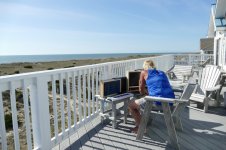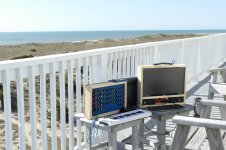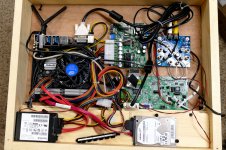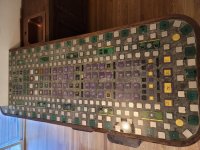It is best to use Windows installtion disk to install Windows 10 on You should know that it is safer to use the Windows installation disk,for me to installed Windows 10 on my computer,i did it with the help of the Windows 10 installation disk.i got caught out in 2006.
i have 2 hard drives for safety.
i decided to upgrade to next version of windows.
no problem went easy.
i was then horrified to find windows had formatted both drives.
i managed to dig out some backup cdroms but i lost a lot of work for good.
since then i unplug 2nd drive if reinstalling windows and keep cdroms and flash drives with data.
even keep one flash drive in the car in case of house fire.
Fixed my old Dell desktop server, which has been partially disassembled for at least a year. Could never get 1 DVD-ROM + 3 HDD SATA devices on it to work properly. I think I narrowed it to 2 issues: the DVD needs to be the 2nd device (B or D port), and WD drives need advanced format disabled. Took a lot of trial and error and many reboots to figure that out 😀
Interesting! I didn't know there could be issues with which sata port something was plugged into. Used to be something you had to check the jumpers for IDE drives, ie were they primary or secondary.
Computers, who needs em 😉
Tony.
Computers, who needs em 😉
Tony.
It doesn't seem to matter on my PC unless I have a M.2 SSD connected then I cant use SATA 1 for external drive.
Sometimes you'll find a couple of grades of SATA controller on a board, each offering a couple of ports. Not entirely the same as a master/slave relationship.
There's always been a concern about putting a buggy, or old and slow, or old and less compatible device in charge.. or in any way close with your system device.
It shouldn't matter any more but it doesn't hurt.
There's always been a concern about putting a buggy, or old and slow, or old and less compatible device in charge.. or in any way close with your system device.
It shouldn't matter any more but it doesn't hurt.
Wanted to try making an ULTRA cheap gaming PC for a while, all we have in the house is low powered browsing computers. All parts used from online classifieds. Its the most powerful computer in the house by a large margin now. Here are pics:
Attachments
-
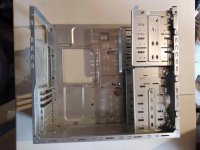 01 - stock chassis.jpg515.8 KB · Views: 215
01 - stock chassis.jpg515.8 KB · Views: 215 -
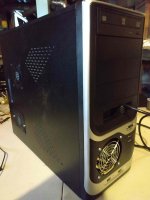 11 - fully assembled.jpg368.5 KB · Views: 120
11 - fully assembled.jpg368.5 KB · Views: 120 -
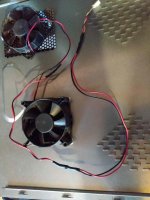 10 - fans on cover.jpg422.2 KB · Views: 112
10 - fans on cover.jpg422.2 KB · Views: 112 -
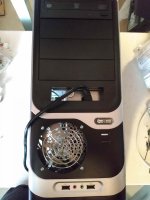 09 - front panel installed.jpg352 KB · Views: 108
09 - front panel installed.jpg352 KB · Views: 108 -
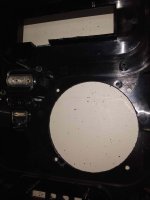 08 - modified front panel.jpg338.5 KB · Views: 113
08 - modified front panel.jpg338.5 KB · Views: 113 -
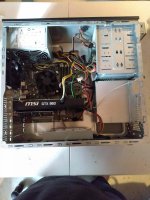 07 - all internals installed.jpg453.7 KB · Views: 112
07 - all internals installed.jpg453.7 KB · Views: 112 -
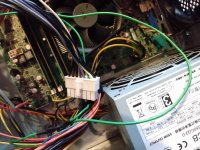 06 - sense lines jumpered.jpg789.5 KB · Views: 214
06 - sense lines jumpered.jpg789.5 KB · Views: 214 -
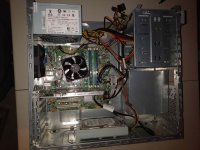 05 - drives mounted.jpg939.5 KB · Views: 212
05 - drives mounted.jpg939.5 KB · Views: 212 -
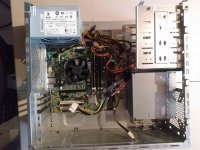 04 - power supplies installed.jpg786.2 KB · Views: 208
04 - power supplies installed.jpg786.2 KB · Views: 208 -
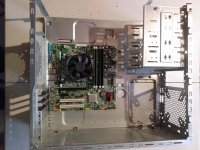 03 - motherboard installed.jpg805.2 KB · Views: 214
03 - motherboard installed.jpg805.2 KB · Views: 214
My favorite mass-market business computer is the Apple Lisa (original model).
There was a professional-grade machine released with a GUI around the same time that had better hardware (higher screen resolution with the superior portrait form factor, graphical co-processor to give the UI 'the snappy', better performance, more sophisticated software such as a font creator/editor) but it was quite expensive and basically no one has heard of it. People have heard of the Xerox stuff but that's not what this one was. I don't even remember the name anymore.
The original Lisa had beautiful (for its time) styling and, when compared with most computers of its time, blew me away with the data density of the screenshots I saw in the computer review book I had from the library. They weren't the simplistic drawing program shots that were used a lot. They were probably from the spreadsheet. (The first Mac was an overpriced toy in most respects, by comparison — although it did get some things right.)
Beyond the styling, it has an incredible (for the time, in the consumer computing bracket) 1 MB of RAM and a "Winchester drive" (the old name for a hard disk).
Sadly, Apple's bad management ruined the platform and also caused design shortcomings to ship (like unreliable floppy drives, a too-slow protected memory kludge because Motorola hadn't managed to produce a decent MMU, no sound capability, the lack of a graphics accelerator chip, and the CPU being clocked at half of what it was capable of). Even with the shortcomings it could have been (with a fix for the floppies) quite the platform. Apple had an (albeit deficient in the database area) office suite long before Microsoft did. More care could have been put in to improve its business relevance, such as by making it compatible with Lotus data.
Anyway, I know a lot about old computers and a lot about recent ones as well. I have lapped CPUs and overclocked them (including precision memory overclocking which is no fun at all on a cheap board that lacks things like a CMOS button on the back panel and an error code LED readout). I have made my own custom coolant for water loops. Etc.
I tried to learn programming but my mind is too soft to handle that. It also didn't help that I couldn't have a computer until I bought a used one myself just out of high school. I used to skip recess to read computer magazines and use the Apple IIs in the school library.
In terms of what I'm up to now, since that was the question. I am trying to avoid subjecting myself to Windows 10 as much as possible, as it's the worst version of Windows ever — and that includes the deplorable 3.x series, ME, the bomb-prone 95 — as well as 98, which had the dubious quality of being regularly unable to update itself successfully.
I have dabbled with Linux and BSD. Both of them are fine for enterprise work but very weak as desktop operating systems, when compared with the polish of macOS. Unfortunately, Apple continues to blithely kill-off functionality in its pursuit of ever-faster planned obsolescence and similar anti-consumer tactics (like selling expensive dongles and replacement cables since theirs snap easily).
Computer game enthusiasts continue to spend money in order to make the things they like cost more money, since they're pouring it into traps like consoles and Windows. All of those things are walled gardens. What they should be putting their money into is Linux + Vulkan + OpenGL. They're also busy funding the QLC NAND trap. But, that's the way of consumerism.
P.S. My favorite CPU is the Fairchild F-8, even though it was apparently stolen from Olympia Werke.
There was a professional-grade machine released with a GUI around the same time that had better hardware (higher screen resolution with the superior portrait form factor, graphical co-processor to give the UI 'the snappy', better performance, more sophisticated software such as a font creator/editor) but it was quite expensive and basically no one has heard of it. People have heard of the Xerox stuff but that's not what this one was. I don't even remember the name anymore.
The original Lisa had beautiful (for its time) styling and, when compared with most computers of its time, blew me away with the data density of the screenshots I saw in the computer review book I had from the library. They weren't the simplistic drawing program shots that were used a lot. They were probably from the spreadsheet. (The first Mac was an overpriced toy in most respects, by comparison — although it did get some things right.)
Beyond the styling, it has an incredible (for the time, in the consumer computing bracket) 1 MB of RAM and a "Winchester drive" (the old name for a hard disk).
Sadly, Apple's bad management ruined the platform and also caused design shortcomings to ship (like unreliable floppy drives, a too-slow protected memory kludge because Motorola hadn't managed to produce a decent MMU, no sound capability, the lack of a graphics accelerator chip, and the CPU being clocked at half of what it was capable of). Even with the shortcomings it could have been (with a fix for the floppies) quite the platform. Apple had an (albeit deficient in the database area) office suite long before Microsoft did. More care could have been put in to improve its business relevance, such as by making it compatible with Lotus data.
Anyway, I know a lot about old computers and a lot about recent ones as well. I have lapped CPUs and overclocked them (including precision memory overclocking which is no fun at all on a cheap board that lacks things like a CMOS button on the back panel and an error code LED readout). I have made my own custom coolant for water loops. Etc.
I tried to learn programming but my mind is too soft to handle that. It also didn't help that I couldn't have a computer until I bought a used one myself just out of high school. I used to skip recess to read computer magazines and use the Apple IIs in the school library.
In terms of what I'm up to now, since that was the question. I am trying to avoid subjecting myself to Windows 10 as much as possible, as it's the worst version of Windows ever — and that includes the deplorable 3.x series, ME, the bomb-prone 95 — as well as 98, which had the dubious quality of being regularly unable to update itself successfully.
I have dabbled with Linux and BSD. Both of them are fine for enterprise work but very weak as desktop operating systems, when compared with the polish of macOS. Unfortunately, Apple continues to blithely kill-off functionality in its pursuit of ever-faster planned obsolescence and similar anti-consumer tactics (like selling expensive dongles and replacement cables since theirs snap easily).
Computer game enthusiasts continue to spend money in order to make the things they like cost more money, since they're pouring it into traps like consoles and Windows. All of those things are walled gardens. What they should be putting their money into is Linux + Vulkan + OpenGL. They're also busy funding the QLC NAND trap. But, that's the way of consumerism.
P.S. My favorite CPU is the Fairchild F-8, even though it was apparently stolen from Olympia Werke.
"but very weak as desktop operating systems"
I suggest dabbling some more. Lots of distros and lots of desktop environments to explore - and even if you don't find exactly what you want, you can customize.
Manjaro is all the rage right now. Maybe that would be a good one for you to try.
I've tried a lot of distros (over 25 years) and in the end it doesn't matter much to me, as long as there is a decent package manager and MATE desktop environment can be installed. My current goto is Ubuntu MATE Ubuntu MATE | For a retrospective future
I suggest dabbling some more. Lots of distros and lots of desktop environments to explore - and even if you don't find exactly what you want, you can customize.
Manjaro is all the rage right now. Maybe that would be a good one for you to try.
I've tried a lot of distros (over 25 years) and in the end it doesn't matter much to me, as long as there is a decent package manager and MATE desktop environment can be installed. My current goto is Ubuntu MATE Ubuntu MATE | For a retrospective future
Its the most powerful computer in the house by a large margin now. Here are pics:
I see dedication and passion.


I see dedication and passion.

Thanks for the compliment, but I would have gone with "handy" and "frugal". I have more than enough leftover parts to make a 2nd PC: I will just rivet together pieces of case until it can stand upright 😀
>I will just rivet together pieces of case until it can stand upright
I've got that beat; I just screw the MB to a piece of wood, using little plastic tube snippets for standoffs. For a minute there I thought the non-machine threads would bust through the PTHs and short out the inner planes, but that didnt happen - there must be a little clearance in there.
Frugal_Garage_System. Feeds ~36" monitor guts hanging off the wall behind my workbench. Makes a nice big oscilloscope display for seeing when an audio amplifier clips. Plays background music for when I'm working out there. Handy to look up stuff on line without having to walk back into the house. Runs LabVIEW, REW, 4 bands of dynamic range expansion via 32 bit ReaXcomp on Foobar playback. Crashes when I try to add a 5th band - not the wood platform's fault.
I'd show a picture but, it'd be a little too embarrassing. Plus I'd need to clean up which is truly a someday operation.
I've got that beat; I just screw the MB to a piece of wood, using little plastic tube snippets for standoffs. For a minute there I thought the non-machine threads would bust through the PTHs and short out the inner planes, but that didnt happen - there must be a little clearance in there.
Frugal_Garage_System. Feeds ~36" monitor guts hanging off the wall behind my workbench. Makes a nice big oscilloscope display for seeing when an audio amplifier clips. Plays background music for when I'm working out there. Handy to look up stuff on line without having to walk back into the house. Runs LabVIEW, REW, 4 bands of dynamic range expansion via 32 bit ReaXcomp on Foobar playback. Crashes when I try to add a 5th band - not the wood platform's fault.
I'd show a picture but, it'd be a little too embarrassing. Plus I'd need to clean up which is truly a someday operation.
Until 2006, I was a staunch defender of MS Windows but that changed when a work colleague gave me a CD telling me it contained a full operating system. I did not belief it was possible, until curiosity won over, and tried to boot it. When the OS loaded, I could not believe my eyes: it was an operating system not requiring a time consuming installation much unlike Windows. This was enough for me to, eventually, after a year, I converted all my operating systems to Debian.
At first, I was like living in an alien world as I could not use a terminal efficiently like most other Debian users. However, I was convinced of the terminal's power and pervered until I could use it.
Thanks to the use of terminals and compilers, Linux gave me a thrilling computing experience Windows could only offer for thousands of Euros.
At first, I was like living in an alien world as I could not use a terminal efficiently like most other Debian users. However, I was convinced of the terminal's power and pervered until I could use it.
Thanks to the use of terminals and compilers, Linux gave me a thrilling computing experience Windows could only offer for thousands of Euros.
I've got that beat; I just screw the MB to a piece of wood
Been there, built that.
I have a bunch of PC's. All are DIY builds, but I have been building my own computers since SWTPC (the Tiger amps guys) came out with their MC6800 system in 1975. The computer club at the Motorola plant where I worked was making DIY clones of the Apple II in the late 70's and IBM PC clones by the mid 80's.....I held the plant record for overclocking (before that was even a thing). I had a 16 MHz Intel 80386 chip running reliably for over two years at 40 MHz. I glued a large head sink to the top of the ceramic chip after the white paint peeled off somewhere around 32 MHz.
I usually have some sort of portable PC for making music and for storing and editing pictures and video while on vacation, or otherwise away from home. Today I am actually using a MSI gaming laptop that I purchased, verified functionality, then ripped apart and hot-rodded and overclocked the core i7, added 16 GB of fast ram, and 2.5 TB of NVMe SSD storage.
I built the one shown here in 2017. It is obviously a well planned DIY build that is carefully constructed from scrap wood and held together with sheetrock screws. There are two SSD's for the usual storage and boot drives and a 2TB spinning Samsung for pictures and video. The motherboard in an AsRock H270M/ITXac with a Core i7-7700T and 16 GB of ram in it. The small green board is the power supply. It accepts 12 volts and runs everything. The large green board came out of a 19 inch monitor, it drives the LCD. The small blue board is a TI EVB board for class D chip amp, making 10 WPC.
The front side of this box contains a 19 inch 1920 X 1080 ACER display that I ripped out of it's plastic and two Tang Band speakers. There is a scrap piece of red PC board material with the USB and headphone jacks between the speakers. It can be seen in a few places on a vacation trip to the outer banks in 2018. It is running Ableton Live, a Digital Audio Workstation used for composing and making music. I also took about 15,000 pictures on this trip and assembled them into time-lapse videos in this PC.
The blue faced box with 53 multi colored knobs is a music synthesizer I built using similar wood crafting techniques.....but I took the time to miter the corners. There are two small naked PC board synth's on top of it in the last picture. They still have no clothes today.
Attachments
Last edited:
I can appreciate your sentiments.I have dabbled with Linux and BSD. Both of them are fine for enterprise work but very weak as desktop operating systems, when compared with the polish of macOS.
As a point of historical interest, macOS is based on BSD. It continues to strive for compatibility.
Another is that Linux and BSD don't have a graphical user interface. It is an add-on, and is often associated with distributions, of which there are many with varying priorities. Besides, a Linux or BSD aficionado wouldn't respect a pig wearing a dress.
Despite having used Windows since it came out I still find myself reverting to DOS for some functions.
I have to compile software for CDROM's to send out.
My software has about 3,000 files in it which is way to big for zipping using Winzip.
So i use dos to delete *.sch and *.pcb files which aren't necessary for the build.
To do it Windows would be a real pain as there are hundreds of them.
I have to compile software for CDROM's to send out.
My software has about 3,000 files in it which is way to big for zipping using Winzip.
So i use dos to delete *.sch and *.pcb files which aren't necessary for the build.
To do it Windows would be a real pain as there are hundreds of them.
My pc recently started playing up with loads of BSOD's.
I reinstalled Windows and it was the same.
I did a hard disc check and that was fine.
I ran a RAM test program and that was fine.
So in desperation removed one of the RAM chips.
PC was fine.
The RAM chip was fairly new so thought it should be OK.
So got motherboard manual out.
The part on RAM chips says they should be installed in pairs in same colour sockets.
So duly installed both RAM chips in same colour sockets and its been fine since.
I reinstalled Windows and it was the same.
I did a hard disc check and that was fine.
I ran a RAM test program and that was fine.
So in desperation removed one of the RAM chips.
PC was fine.
The RAM chip was fairly new so thought it should be OK.
So got motherboard manual out.
The part on RAM chips says they should be installed in pairs in same colour sockets.
So duly installed both RAM chips in same colour sockets and its been fine since.
Things are simpler if you only have two RAM slots. Otherwise it's that famous acronym, RTFM. 😀
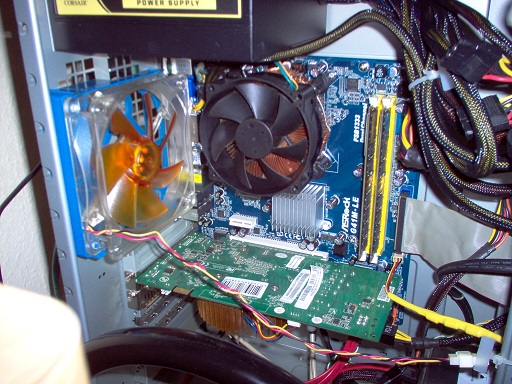
I have always had a good time with Windows. Just we all hate putting our hands in our pocket to pay for it.
Don't underestimate the World's most secure operating system, Linux:
Enterprise Open Source and Linux | Ubuntu
It's come a long way. And it's still free.
I have always had a good time with Windows. Just we all hate putting our hands in our pocket to pay for it.
Don't underestimate the World's most secure operating system, Linux:
Enterprise Open Source and Linux | Ubuntu
It's come a long way. And it's still free.
- Home
- Member Areas
- The Lounge
- The computer thread

